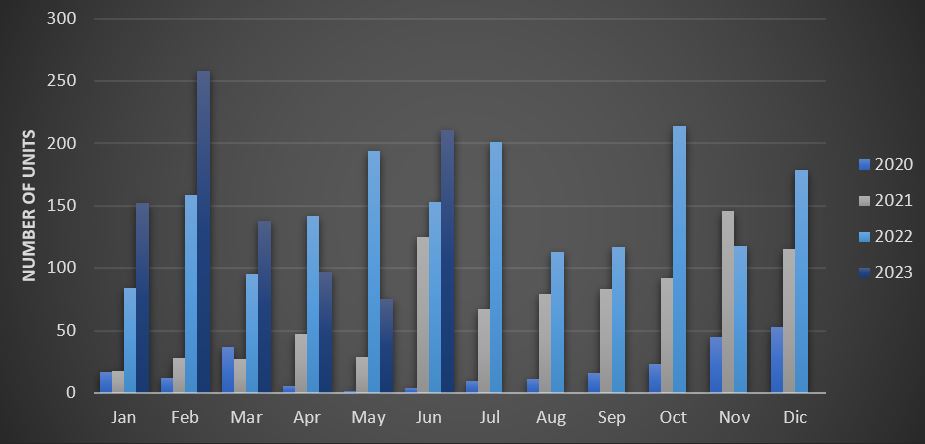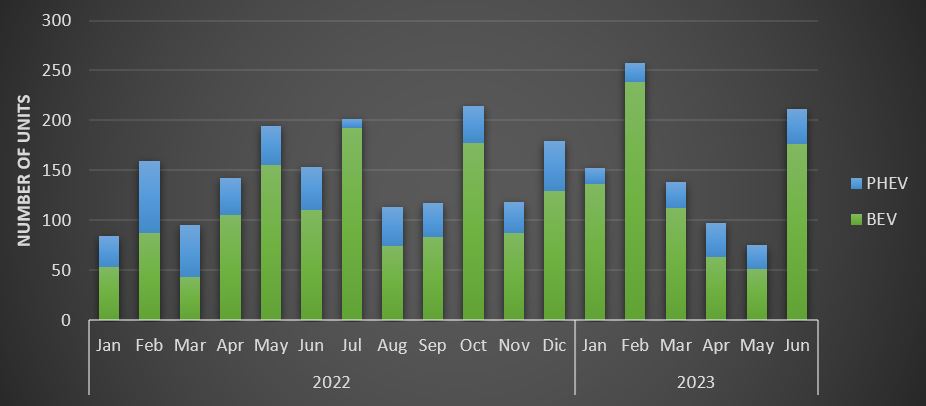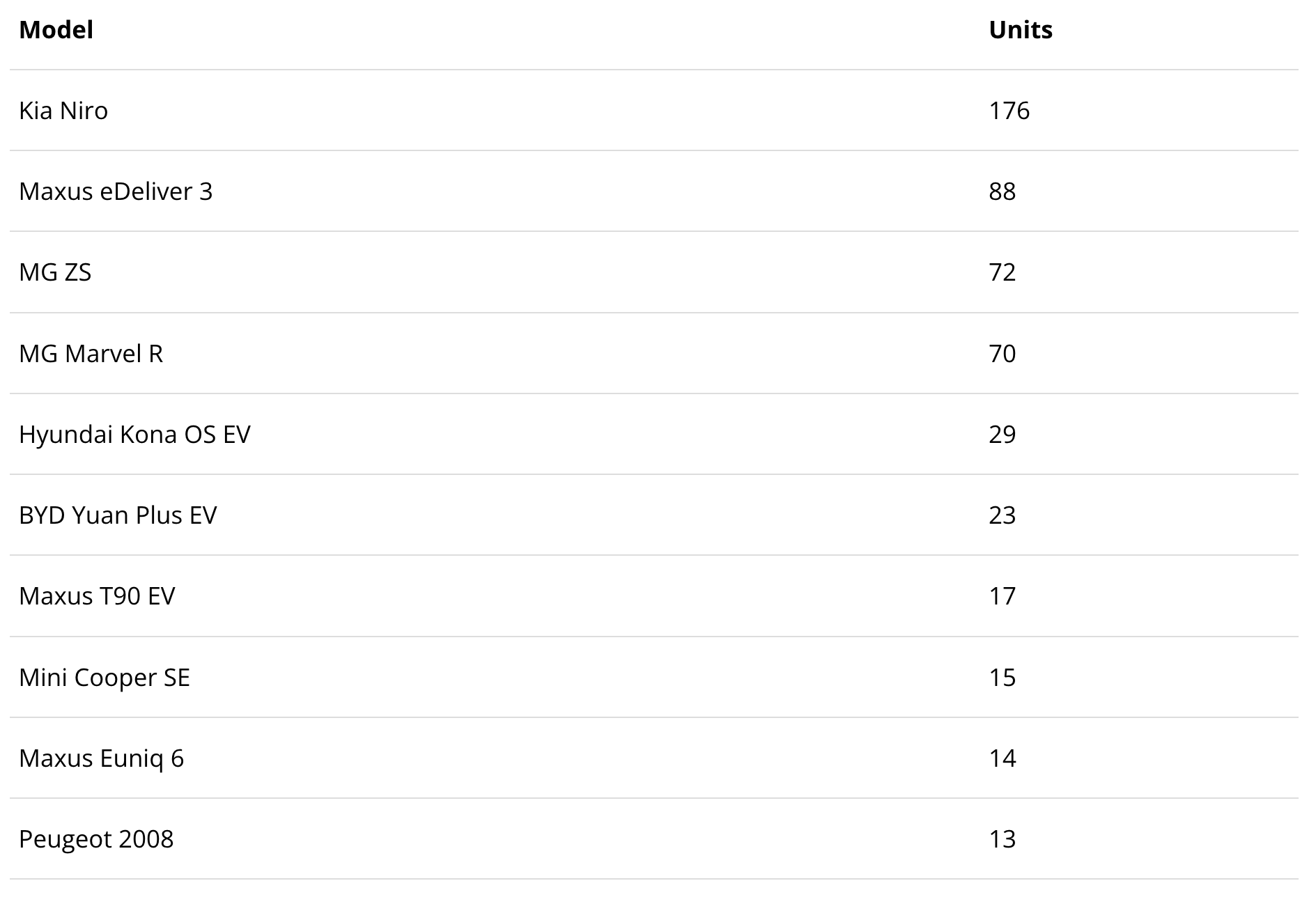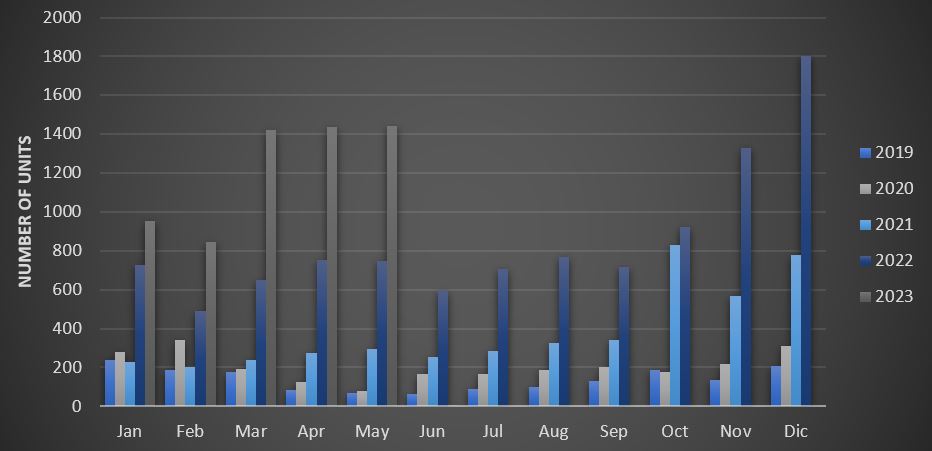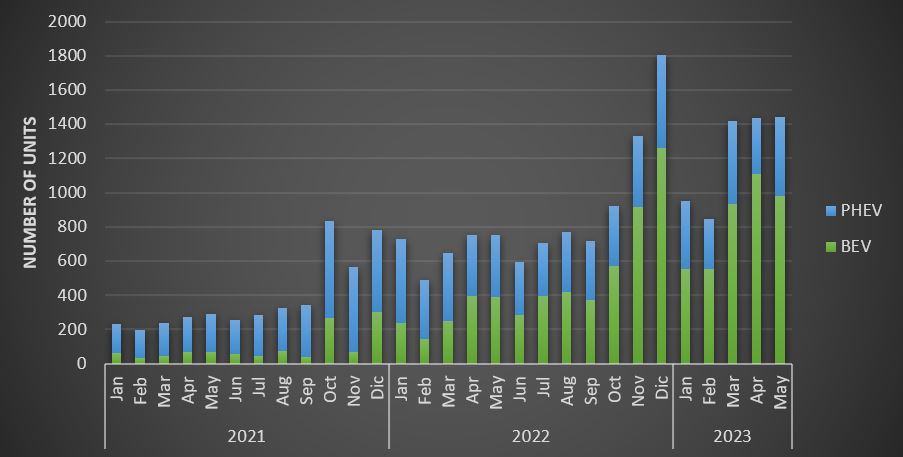
Following up on our Latin American EV Market series, we continue now with countries that are further ahead of the “Laggards” but can’t be considered leaders. If you haven’t read it yet, you can find the previous article here: Latin America EV Market Share Part 1.
In this article, we’ll finally see countries surpassing the symbolic 1% market share, as well as meet some of the fastest growing EV markets in the region. So, let’s begin!
#6. Chile (0.6% plug-in market share)
Cue the collective indignation.
Sure, Chile is technically behind Ecuador and Panama in market share, but it has one of the most complete charging networks in the region and has recently surpassed Colombia as the country with the largest electric bus fleet anywhere outside of China. Even though things aren’t as hot as they should be, this is a country that’s trying, and I found it unfair to relegate it to the laggards group.
159,211 vehicles were sold in Chile in H1 2023. Of these, 777 were BEVs and 154 were PHEVs, for a 0.5% and 0.1% market share, respectively. It’s important to clarify that the plug-in sales here refer exclusively to light vehicles, as the official data does not specify how many electric trucks and buses were sold in this period (nor in the one before it). According to local newsletters, Chile purchased 107 new buses in H1 2023, so the actual market share could be a bit higher, almost reaching 0.7%. However, heavy duty vehicles don’t appear in the statistics we have access to
Monthly Plug-in Vehicle Sales in Chile (Light Vehicles)
A more detailed look at the data presents Chile as a heavily BEV-oriented market, with BEV sales increasing 40% YoY but PHEV sales decreasing by nearly 40%:
Monthly BEV and PHEV Sales in Chile (Light Vehicles)
All this happened amidst severe inflation and a significant reduction in overall vehicle sales — the total market decreased 30% from H1 2022 to H1 2023. This means that EVs remain compelling even amidst general economic slowdowns and despite being far more costly than their ICE competitors. Until prices come down, this trend bring us hope for the transition in the region.
At last, Chile finally overcomes the curse of “electrified” vehicles and offer us a comprehensive top 10 that shows the Kia Niro as the undisputed sales leader in the country:
Unsurprisingly, 6 out of the top 10 are Chinese models. Consider this an omen for the rest of the world: the Chinese are coming (if they haven’t come yet) … and they bring affordable EVs with them!
In other news, the BYD Dolphin arrived in Chile in July 2023. The cost for the 45kWh version will be $34,000. EVs, it seems, will remain expensive in the country for a little bit longer. Though, we expect some brand to start a price war soon. MG, perhaps? The MG4 is a great option not yet available there.
#5. Mexico (1% plug-in market share)
And, finally, we arrive at the symbolic 1% market share milestone!
Now, I sort of had to cheat a little bit with Mexico. See, the country is finally presenting data for plug-in vehicles (last time, I had to manually sort the models that I could identify as BEVs, which inevitably led to under-counting). However, despite a long wait for the country to release the data, I could only find it up to May, so we will only be presenting data for the first 5 months of 2023 in this case.
Not that it matters much. Mexico, we could say, is our Zero to Hero story for the year. Not long ago, the country presented marginal EV sales not unlike Argentina, but from 2021 onwards, the growth rate has been exponential (90% in 2021, 120% in 2022, 80% so far in 2023), allowing the country to go from 0.1% market share in 2019 to 1% in 2023, a 10-fold increase in just four years! During the first five months of this year 560,680 light and heavy vehicles were sold in Mexico: 4,132 of them were BEVs (0.75% share) and 1,966 were PHEVs (0.35% share).
Plug-in Sales in Mexico (Light & Heavy Vehicles)
Nearly all growth has come from BEVs, which presented an amazing 400% increase in 2022, and 190% YoY so far in 2023. PHEV sales, meanwhile, grew only 30% in 2022 and are so far stagnant in 2023. This growth has occurred amidst a boom in vehicle sales, with 22% growth in H1 2023 — though, it’s still 30% under the numbers of 2019.
BEV and PHEV Monthly Sales in Mexico
Mexico is also the largest ICE and EV manufacturer in Latin America, and its lead should only grow in the years to come as brand after brand chooses it for their EV production in the region. Biden’s IRA (Inflation Reduction Act) seems to have had a big impact here, and both legacy and new brands are setting up their shops in Mexico — most important of all Tesla, but also JAC, Kia, BMW, GM, Ford, Audi, Jetour, MG, and probably at least a few others that I’m missing. Funnily enough, we don’t know of BYD having plans for manufacturing in Mexico, having instead chosen Brazil.
Sadly, sales per brand or model are not available so far. Though, most news outlets expect the small, locally produced JAC E10X to keep the reign in 2023 due to its affordable(ish) price: $26,000.
Honorary mention: Dominican Republic (1 to 2.5% BEV market share in 2022)
The Dominican Republic is a relevant player in the EV landscape in Latin America. However, the country provides no access to public data and is not large enough to make it to the regional newsletters, so it is very hard to get any sort of information.
Because of this, the most recent data I could find was for — brace yourselves — October 2022, when the country’s sales totaled 598 BEVs so far for that year. Even the Dominican newsletters devoted to EVs (and there are a couple) don’t have more recent news regarding national sales. It seems the information simply doesn’t exist.
As for total sales … well, let me tell you a funny story. The Dominican Republic has a very particular classification for motor vehicles: you have personal vehicles, motorcycles, vans, buses, trucks, all the normal stuff … and then you have jeep-like vehicles (yipetas). And these yipetas, I kid you not, are the most sold type of vehicles after motorcycles. Yes, more popular than regular cars and SUVs.
Therefore, BEV market share will depend on whether you consider these jeep-like vehicles as cars or not. If that’s the case, then 56,137 total vehicles were sold in Dominican Republic in the first 10 months of 2022, presenting a BEV market share of 1%. However, if we exclude them and only consider “regular” cars, 23,240 vehicles were sold in this period and BEVs rise to an impressive 2.5% market share.
This means 10 months ago the Dominican Republic presented a market share ahead of any other country so far in this list today. According to regional media, BYD, Tesla, and Hyundai made the sales podium, in that order.
#4. Brazil (1.6% plug-in market share)
Last on our list today, we arrive at Brazil, Latin America’s largest car market by far.
Brazil, like Argentina, has a very protected market. However, it’s been having less economic hardship in recent times, and it seems it also has a more positive attitude towards EVs, meaning a far larger market share and many more EVs on the streets.
In the first 6 months of 2023, 933,524 vehicles were sold in the country, 3,777 of which were BEVs (0.4% market share) and 11,475 of which were PHEVs (1.2% market share). Brazil is a particular case, as, in opposition to most other countries (that we have data for), Brazil has a stagnant BEV market (only 11% growth in H1 2023) and booming PHEV sales (205% growth in H1 2023). Since Brazil’s total vehicle sales increased in H1 2023 by over 30%, this means that this year’s BEV share has actually fallen YoY:
Monthly plug-in sales in Brazil (light and heavy vehicles)
We’re yet to see if the recent arrival of the BYD Dolphin — at a $31,000 cost — and the price war it seems to have started will improve the situation for BEVs, or if we will have to wait until BYD’s factory is up and running to see Brazil’s numbers improve. For now, even though it’s not ideal, at least it seems PHEVs are doing the lifting.
It is perhaps important to mention that Brazil and Mexico present, by far, the most stable macroeconomic situations in the region, having almost controlled inflation and thus presenting low interest rates — hence the booming vehicle markets.
As for the leaders of the market, the information presented combines PHEV and HEV models, so it’s hard to give an accurate list, but all top 5 plug-ins sold in Brazil seem to be PHEVs. These are the Chery Tiggo 5X (PHEV/HEV), Volvo XC60 (PHEV), GWM Haval H6 (PHEV/HEV), Chery Tiggo 8 (PHEV/HEV), and BYD Song Plus (PHEV/BEV).
With this, we finish the second part of our report. Stay tuned for the final part, involving the EV Transition leaders in the region!
I don’t like paywalls. You don’t like paywalls. Who likes paywalls? Here at CleanTechnica, we implemented a limited paywall for a while, but it always felt wrong — and it was always tough to decide what we should put behind there. In theory, your most exclusive and best content goes behind a paywall. But then fewer people read it! We just don’t like paywalls, and so we’ve decided to ditch ours. Unfortunately, the media business is still a tough, cut-throat business with tiny margins. It’s a never-ending Olympic challenge to stay above water or even perhaps — gasp — grow. So …

